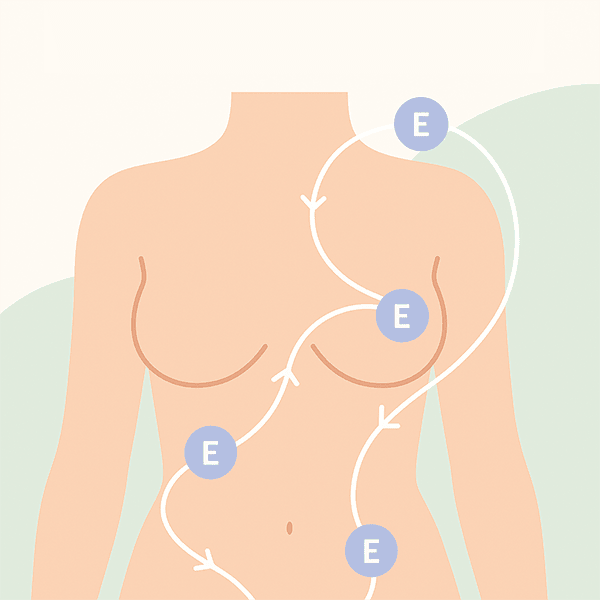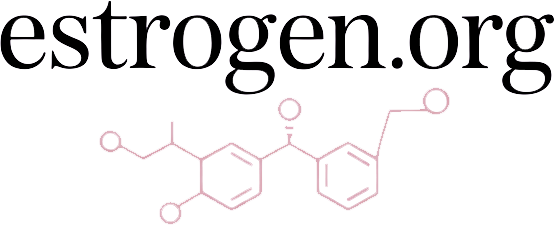Estrogen in Women
How estrogen shapes a woman's body, health, and hormonal journey.

Estrogen's Role in Female Development
- Breast Development: Estrogen stimulates breast tissue growth, development of milk ducts, and deposition of fat, creating the female breast contour during puberty.
- Menstrual Cycle Regulation: Works with progesterone to orchestrate the monthly cycle, triggering endometrial growth and ovulation.
- Fat Distribution: Directs fat storage to the hips, thighs, and buttocks, creating the characteristic female body shape.
- Bone Growth: Critical for achieving peak bone mass during development and maintaining bone density throughout life.
- Reproductive Organ Function: Maintains the health of the vagina, uterus, and fallopian tubes, ensuring proper function for reproduction.
Estrogen Through the Life Cycle
Puberty
Surge in estrogen triggers menstrual cycles, breast development, and sexual maturity. Typically begins between ages 8-13.
Reproductive Years
Estrogen levels fluctuate monthly; central to fertility and ovulation. Peaks in the late 20s and early 30s.
Pregnancy
Dramatic increase in estrogen (especially estriol); supports fetal development, prepares body for birth, and stimulates milk production.
Perimenopause
Estrogen levels begin to decline, often erratically. Typically begins in the 40s and can last 4-8 years with symptoms like irregular periods.
Menopause
Marked by a permanent drop in estrogen; associated with symptoms like hot flashes, mood shifts, and bone density loss. Usually occurs between 45-55.
Postmenopause
Estrogen remains low; risk of osteoporosis and heart disease increases. New balance is established with lower but stable hormone levels.
Health Effects of Estrogen in Women
Brain & Mood
Supports neurotransmitter function, affecting cognitive function, memory, and emotional balance. Estrogen receptors throughout the brain influence mood stability.
Heart
Influences cholesterol levels by increasing HDL (good) cholesterol and decreasing LDL (bad) cholesterol. Helps maintain blood vessel elasticity and healthy cardiovascular function.
Bones
Preserves bone density and strength by inhibiting bone breakdown and promoting calcium absorption. Women with lower estrogen levels face increased risk of osteoporosis.
Skin
Maintains skin elasticity, hydration, and collagen production. Helps skin retain moisture and supports wound healing and tissue repair processes.
Reproductive Health
Critical to menstrual regulation, fertility, and pregnancy. Controls the thickening of the uterine lining in preparation for potential pregnancy and supports vaginal health.
Signs of Estrogen Imbalance in Women
Recognizing these signs can help identify potential estrogen imbalances:
Irregular Periods
Changes in frequency, duration, or flow of menstrual cycles
Hot Flashes
Sudden feelings of warmth, often most intense in the face, neck, and chest
Mood Swings
Unexpected emotional changes, irritability, or depression
Vaginal Dryness
Reduced vaginal lubrication leading to discomfort or pain during intercourse
Low Libido
Reduced interest in sexual activity or difficulty becoming aroused
Fatigue
Persistent tiredness or lack of energy despite adequate rest
Bone Loss
Gradual decrease in bone density, increasing risk of fractures
Insomnia
Difficulty falling asleep or staying asleep
Note: These symptoms can have many causes beyond estrogen imbalance. Always consult with a healthcare provider for proper diagnosis and treatment.
Common Conditions Related to Estrogen
Estrogen Therapy in Women
Estrogen Therapy in Women
Estrogen therapy, also called hormone replacement therapy (HRT) when combined with progesterone, may be prescribed to alleviate symptoms associated with hormonal changes or deficiencies.
Common uses include:
- Managing moderate to severe menopausal symptoms like hot flashes and night sweats
- Preventing bone loss and reducing fracture risk in postmenopausal women
- Treating vaginal dryness, itching, and discomfort
- Supporting hormonal balance in younger women with primary ovarian insufficiency
Available forms:
Pills taken daily
Applied to skin, changed 1-2 times weekly
Local delivery for vaginal symptoms
Applied to skin daily
Important Health Considerations:
Hormone therapy carries both benefits and risks that vary based on individual health factors, family history, age, and duration of use. A personalized approach with ongoing medical supervision is essential.
